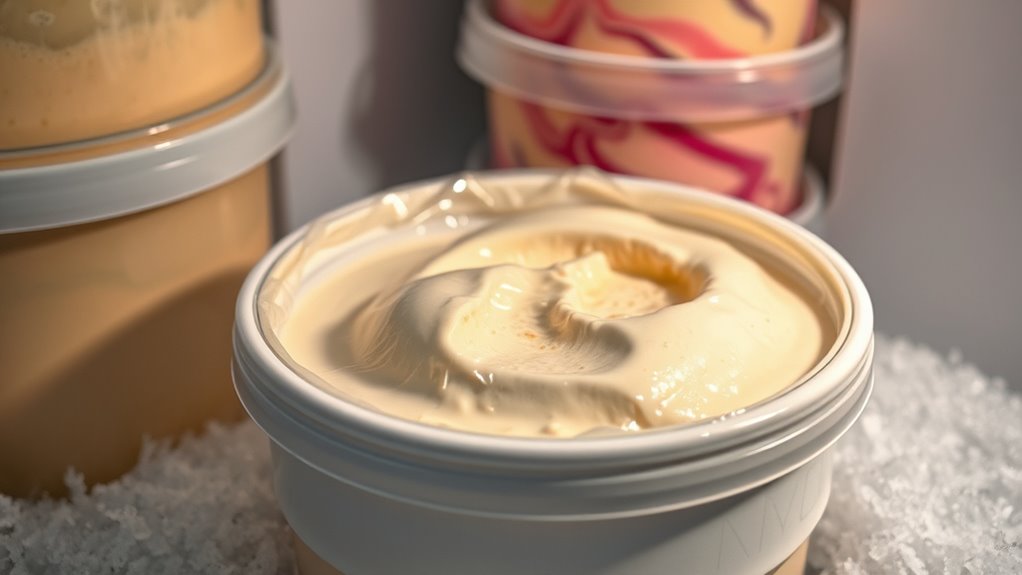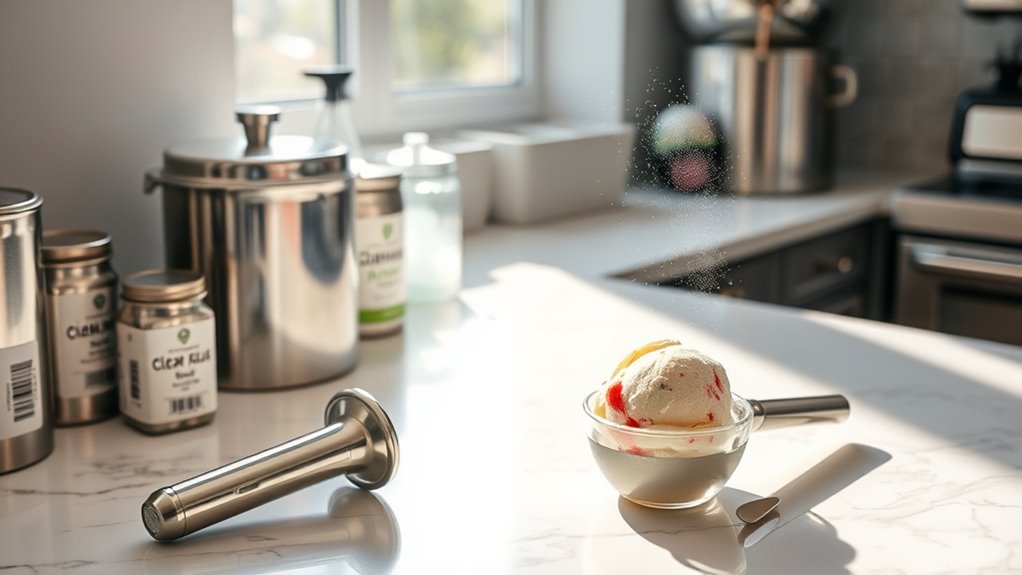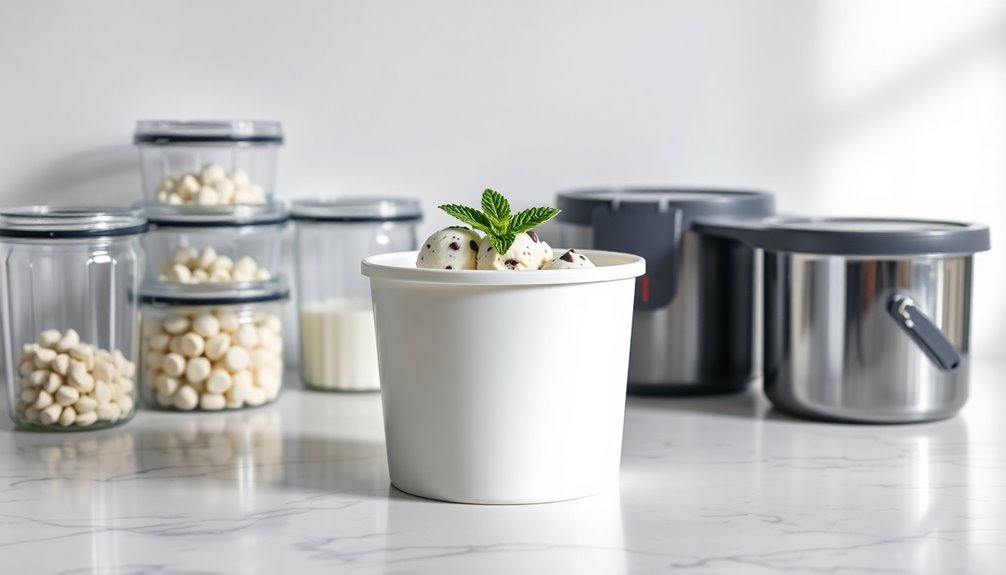To prevent odor absorption in ice cream, always store it in airtight containers and keep it away from strong-smelling foods like fish sticks and garlic sauce in your freezer. Tightly seal the container lids and consider wrapping the ice cream in plastic wrap for extra protection. It’s best to store it in the coldest part of your freezer, like the back center shelf, to maintain its freshness. There’s more you can do to keep your ice cream tasting great!
Key Takeaways
- Store ice cream in airtight containers to prevent odors from infiltrating and affecting its flavor.
- Wrap ice cream in plastic wrap or waxed paper for added protection against strong smells.
- Keep ice cream away from strong-smelling foods in the freezer to minimize scent transfer.
- Regularly clean the freezer to eliminate lingering odors and spills that may affect ice cream.
- Maintain a consistent freezer temperature between -5°F and 0°F to preserve ice cream quality and prevent odor absorption.
Understanding Odor Absorption in Ice Cream

Understanding odor absorption in ice cream is essential if you want to enjoy its pure, creamy flavor. Ice cream’s dairy content makes it highly susceptible to picking up odors, especially when stored near strong-smelling foods like frozen fish sticks or garlic pasta sauce.
Over time, these odors can considerably alter the taste of your favorite dessert. To prevent odor absorption, always store ice cream in a tightly sealed container. Using plastic wrap or waxed paper between the lid and ice cream adds an extra layer of protection.
Ideally, keep your ice cream in a separate chest freezer, which maintains lower temperatures and minimizes odor transfer. Regularly check your freezer for strong odors and practice proper food storage to safeguard your ice cream’s delightful flavor.
Importance of Proper Storage

Proper storage of ice cream is essential if you want to savor its rich flavor without unwanted tastes.
Dairy products, especially ice cream, easily absorb strong odors from nearby items, which can ruin its delightful essence. To combat this, always keep the container lid tightly closed, and use plastic wrap or waxed paper between the lid and the ice cream for extra protection.
Placing the ice cream carton inside a Ziploc bag and removing excess air minimizes odor exposure and helps maintain its scoopability.
To keep your ice cream fresh, store it in a Ziploc bag and remove excess air for optimal flavor and texture.
Store your ice cream in the coldest part of the freezer, away from strong-smelling foods like garlic or frozen fish sticks, to preserve its original taste and quality.
Proper storage is key to enjoying every scoop!
Ideal Freezer Conditions

To keep your ice cream fresh and free from odors, you need to maintain the right freezer conditions.
Aim for a temperature between -5°F and 0°F and store your ice cream in the coldest part of the freezer, typically the back center shelf.
Avoid the door, as those temperature fluctuations can ruin the flavor and texture you love.
Optimal Freezer Temperature
When it comes to preserving the quality of ice cream, maintaining an ideal freezer temperature is essential. The best freezer temperature for storing ice cream is between -5°F and 0°F. This range helps prevent odor absorption and keeps your ice cream tasting fresh.
Avoid storing ice cream in the freezer door, where temperature fluctuations can lead to freezer burn and affect flavor. Instead, place your ice cream in the back of the freezer, where temperatures are more stable.
Be mindful of strong-smelling foods nearby, as odors can still penetrate even at freezing temperatures. If possible, consider using a separate chest freezer, which maintains lower temperatures and reduces exposure to fluctuating conditions—perfect for ideal preservation.
Proper Placement Techniques
Finding the right placement for your ice cream in the freezer can make a significant difference in preserving its quality. To effectively store ice cream, use proper placement techniques by placing it in the coldest part of your freezer, typically the back center shelf.
Avoid the freezer door, as it experiences temperature fluctuations that can lead to odor absorption. Keep your ice cream away from strong-smelling items like frozen fish sticks and garlic pasta sauce to prevent scent transfer.
If you have a separate chest freezer, consider utilizing it to maintain lower, stable temperatures. Finally, regularly check that the lid of your ice cream container is tightly closed, and consider adding plastic wrap or waxed paper for an extra barrier against odors.
Preventing Freezer Burn

Preventing freezer burn in ice cream is essential for preserving its creamy texture and rich flavor, especially since ice crystals can ruin your favorite treat.
To keep your ice creams in top condition, tightly close the lids and wrap them in plastic wrap or wax paper. This reduces air exposure and stops ice crystals from forming. You can also place the carton in a Ziploc bag, removing excess air to maintain scoopability and texture.
Regularly check your freezer’s temperature, keeping it between -5°F and 0°F to avoid fluctuations. Ultimately, store your ice creams away from the freezer door to minimize temperature changes and enhance their flavor and texture.
These simple steps will help you enjoy your ice creams longer!
Techniques for Enhancing Freshness

To keep your ice cream tasting fresh and delicious, it’s crucial to protect it from unwanted odors in the freezer. Here are some techniques for enhancing freshness during food storage:
| Technique | Description |
|---|---|
| Keep it sealed | Always close the container lid tightly; use plastic wrap for extra protection. |
| Store wisely | Place ice cream away from strong-smelling items like garlic and fish. |
| Encapsulate | Use a Ziploc bag to encase the carton, removing excess air to minimize odors. |
| Maintain temperature | Keep your freezer between -5°F and 0°F, ideally at the back for even cooling. |
Regular Maintenance and Cleaning

Keeping your ice cream fresh goes beyond just sealing the container and storing it properly; regular maintenance and cleaning of your chest freezer also play a significant role.
Start by cleaning your freezer regularly to eliminate any spoiled or strong-smelling items that could contaminate your ice cream. Utilize natural deodorizers like baking soda or activated charcoal to absorb lingering odors.
Make sure to check the seals and gaskets, as proper maintenance prevents air exchange that can lead to odor absorption. Regularly inspect and replace your odor absorbers to keep smells at bay.
Finally, perform a deep clean with a vinegar solution or baking soda to tackle stubborn odors, ensuring your ice cream maintains its delightful flavor. Consistent cleaning processes are essential for optimal performance and to prevent odor absorption.
Tips for Long-Term Ice Cream Storage

To keep your ice cream tasting fresh, it’s essential to focus on proper container sealing and ideal freezer placement.
Always check expiration dates to guarantee you enjoy your treats at their best.
With a few simple steps, you can maximize flavor and prevent unwanted odors from ruining your favorite dessert. Additionally, be aware that ice cream’s average consumption per person in the U.S. can lead to rapid turnover, making freshness even more critical.
Proper Container Sealing
While you may love the rich flavors of your ice cream, improper sealing can lead to unwanted odors infiltrating your beloved treat.
To guarantee effective cream storage, always keep the ice cream container lid tightly closed. This minimizes exposure to odors from other foods.
For added protection, use plastic wrap or waxed paper between the lid and the ice cream surface to create an extra barrier against air and odors. You can also place the ice cream carton inside a Ziploc bag, removing excess air before sealing it.
Regularly check the freezer temperature, ideally between -5°F and 0°F, and store the ice cream in the coldest part of the freezer to maintain ideal conditions and prevent odor absorption.
Ideal Freezer Placement
Proper sealing isn’t the only factor that affects your ice cream’s quality; where you store it in the freezer is equally important.
To maintain consistent temperatures and prevent odor absorption, make sure to place your ice cream in the coldest part of the freezer, typically the back center shelf. Avoid the freezer door, as it experiences frequent temperature fluctuations that can compromise your ice cream’s integrity.
For long-term storage, a chest freezer is ideal, as it maintains lower temperatures and is opened less often, providing stable conditions.
Regularly check and maintain the temperature settings, aiming for between -5°F and 0°F. Consistent cold helps preserve your ice cream’s texture and flavor while reducing the risk of unwanted odors.
Monitor Expiration Dates
Keeping an eye on expiration dates is vital for enjoying your ice cream at its best. While ice cream can technically be stored frozen indefinitely, its quality diminishes over time.
To guarantee you’re savoring the best flavor and texture, you should monitor expiration dates closely. Regularly checking these dates helps you avoid unappetizing flavors that can result from prolonged storage.
If you’re a fan of unique or limited-edition flavors, consuming them before their expiration dates is essential to appreciate their intended taste.
Remember, eating ice cream past its expiration date isn’t recommended, as it can compromise flavor and texture.
Frequently Asked Questions
How Do You Store Ice so It Doesn’t Smell?
To store ice so it doesn’t smell, keep it in a clean, airtight container.
You can also wrap the ice in plastic wrap or waxed paper to add an extra layer of protection.
Make certain your freezer is free of strong-smelling foods that could transfer odors.
Regularly check for any items that might compromise the ice’s freshness, and maintain your freezer temperature consistently to keep your ice crisp and clean.
How to Avoid Smell in Freezer?
Imagine your freezer as a pristine domain, where freshness reigns supreme. To keep this domain odor-free, banish strong-smelling foods like garlic sauce and fish sticks to distant lands.
Regularly inspect for rogue items that threaten your domain’s harmony, and use airtight containers for leftovers to lock away odors.
Clean your freezer with warm water and gentle detergent, and invite natural deodorizers like baking soda to absorb unwelcome scents, ensuring your domain remains a haven of freshness.
Why Does My Ice Cream Smell Bad?
If your ice cream smells bad, it’s likely absorbing odors from nearby foods in the freezer.
Strong scents, like garlic or fish, can seep into your ice cream, altering its flavor and aroma.
Improper storage, like placing it near these items or in the freezer door, makes it more vulnerable.
Ice crystals from air exposure can also affect the taste.
Regularly check your freezer and keep it organized to avoid these issues.
How Do You Prevent Lactose Crystallization in Ice Cream?
Ever wondered why your ice cream’s turning icy and grainy? To prevent lactose crystallization, keep your freezer temperature between -5°F and 0°F.
Incorporate stabilizers like guar gum to enhance texture, and churn the mixture regularly while it freezes to introduce air and break up crystals.
Using high-quality dairy with lower lactose content also helps.
Finally, seal your container well to minimize air exposure, ensuring a creamy treat every time.
Conclusion
By taking the right steps, you can keep your ice cream tasting fresh and free from unwanted odors. Did you know that nearly 30% of ice cream lovers report a decline in flavor due to improper storage? To avoid this, make sure to store your ice cream in airtight containers and keep your freezer at the ideal temperature. With these simple techniques, you can enjoy a delicious scoop every time without any off-putting flavors!










